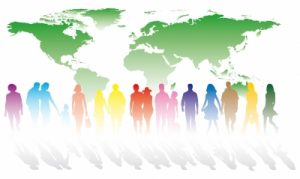By Christine Kukka

A few weeks ago, an ill-informed New England governor proclaimed illegal immigrants were bringing in infectious diseases, including hepatitis, HIV, and tuberculosis. Recently, similar anti-immigration, fear-mongering from presidential candidates has filled the airways.
For hundreds of years, disease has been used as reasons to stop immigration to the United States. During the early 1800s, officials claimed the Irish brought cholera into the country. The Italians were believed to carry polio and tuberculosis was called the Jewish disease. In 1900, the Asian-American community in San Francisco was believed to be infected with bubonic plague that posed a threat to public health. Residents were subjected to mandatory injections with an experimental drug until a court order halted the local public health campaign.
Throughout the 19th and 20th century, “politics was saturated with attacks on immigrants as diseased intruders to the body politic,” wrote American University history professor Alan M. Kraut in Foreign Bodies: The Perennial Negotiation over Health and Culture in a Nation of Immigrants. This dialogue led to revision of the 1882 Immigration Act to exclude, “persons suffering from a loathsome or a dangerous contagious disease” from entry into the United States.
Today, prejudice, ignorance, and anti-immigration sentiment continues to affect public awareness, prevention, and treatment of hepatitis B. In the U.S., hepatitis B infects our most vulnerable residents, many of whom are new immigrants from Asia and Africa. Their access to proper healthcare, including immunization and screening and treatment for hepatitis B is hindered by poverty, lack of insurance, and limited access to culturally-competent healthcare. Today, one in 12 Asian-Americans has hepatitis B and two-thirds of them don’t know it.
In addition to barriers, there remains the fear among immigrants that if they are found to have a chronic infection, they may be expelled from the U.S. It’s no wonder that many immigrants refuse to be tested or treated for hepatitis B. For example, liver cancer from untreated hepatitis B is the second-most common cause of cancer among Vietnamese-Americans. These fears explain why it’s a struggle for public health advocates to screen Asian and African immigrants and others at risk, though there are some success stories.
In some cases, it is true that immigrants have infectious diseases at higher rates than U.S. residents because they lacked access to immunizations and proper healthcare, and were subjected to re-used syringes in their countries of origin. But will publicly acknowledging that reality increase the country’s insecurities about immigration? Will it feed into the stigma surrounding many infectious diseases today? That is the quandary we face.
But haven’t we learned that all it takes for evil to triumph are for good people to stay silent and do nothing? Many years ago, I shared the discrimination and ignorance my daughter, who has hepatitis B, faced at her elementary school. Another health advocate, who had worked on HIV and hepatitis C issues, asked why I didn’t go “public” about the discrimination.
“My daughter is the only non-white student in her class, almost in her school, how can I put her through all that stigma by going public to the media?” I asked him. I ultimately kept quiet and worked in ways that were out of the public limelight, but I’m not so sure I was right. Yes I protected my daughter, but I lost an opportunity to educate a community about the importance of immunization and prevention of blood-borne diseases.
If the AIDS movement had adopted my cautious posture, tens of thousands more would have died and new, life-saving drugs (some of which are used to treat hepatitis B today) would have taken decades longer to develop. Instead of staying silent for fear of inflaming ignorant, anti-immigration sentiment, we need to adopt the AIDS movement’s mantra that silence equals death. We need to speak out, because history has shown us what happens when people stay silent and do nothing.

